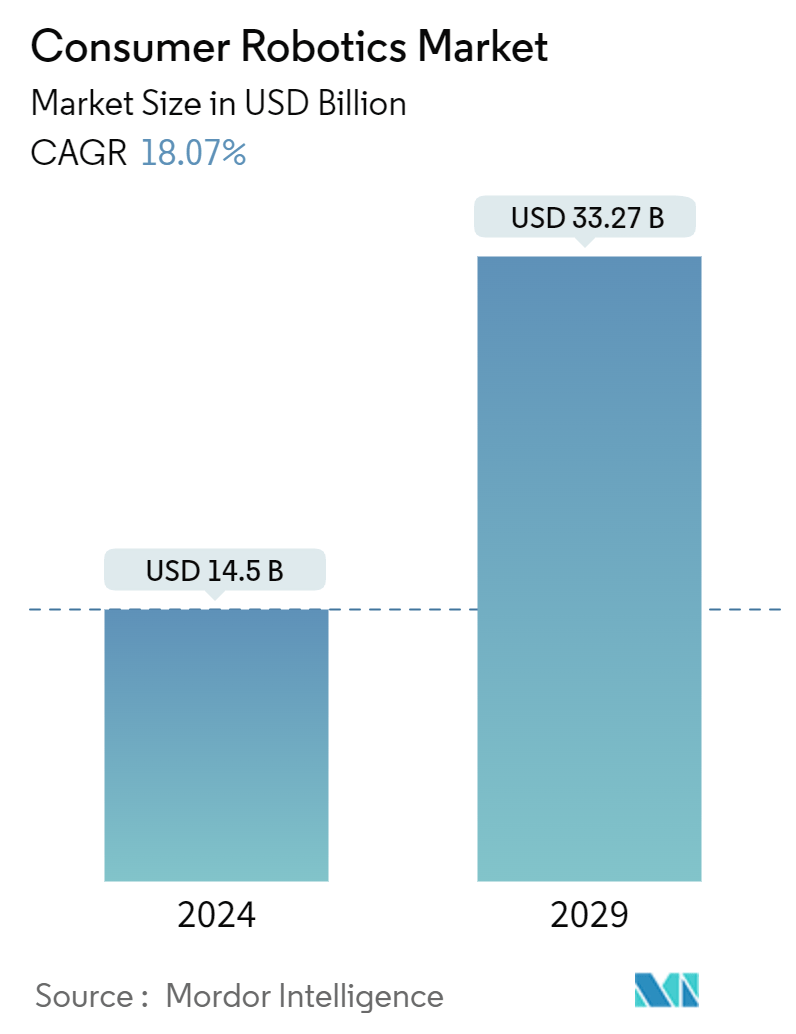Market Size of Consumer Robotics Industry

| Study Period | 2019 - 2029 |
| Market Size (2024) | USD 14.5 Billion |
| Market Size (2029) | USD 33.27 Billion |
| CAGR (2024 - 2029) | 18.07 % |
| Fastest Growing Market | Asia Pacific |
| Largest Market | North America |
Major Players.webp)
*Disclaimer: Major Players sorted in no particular order |
Consumer Robotics Market Analysis
The Consumer Robotics Market size is estimated at USD 14.5 billion in 2024, and is expected to reach USD 33.27 billion by 2029, growing at a CAGR of 18.07% during the forecast period (2024-2029).
Robotics is playing an ever-growing role in the evolution of smart home technology. Due to technological and engineering advancements, robots now execute many tasks with unprecedented accuracy and efficiency. One prominent application is consumer robotics, which empowers individuals to harness the benefits of robotic automation.
• Consumer robotics hold the promise of not just convenience but a transformative impact on human lives. By taking over mundane or repetitive tasks, these robots free up time for more creative pursuits. They also make services more accessible, overcoming barriers of cost and availability. Beyond these advantages, consumer robots enhance physical and cognitive abilities, enabling them to achieve feats that would be challenging without their support.
• In recent years, developed and developing nations have witnessed a surge in demand for consumer robots, primarily due to their increasing affordability and accessibility. For example, US Department of Treasury data highlights a boost in household purchasing power. In 2023, median American workers maintained their 2019 purchasing power and enjoyed an extra USD 1,000 to spend or save, owing to median earnings outpacing price increases. Similarly, data from MOSPI reveals that consumer spending in India topped a record INR 25.6 trillion by the close of Q4 2023. Given these financial trends, consumers are increasingly investing in products that elevate their quality of life, which, in turn, is creating a favorable ecosystem for the market studied growth.
• In addition, the rising adoption of advanced technologies by consumers has fostered a conducive environment for the growth of this market. For example, as consumers increasingly pursue innovative and immersive entertainment experiences, education robots have emerged as a captivating option. These robots, ranging from companions and gaming devices to interactive toys, engage users and promise hours of amusement.
• Technological advancements play a pivotal role in propelling the growth of the examined market. For example, breakthroughs in artificial intelligence and navigation systems, coupled with widespread internet access and the surge of handheld devices like smartphones, tablets, and smartwatches, have significantly bolstered the widespread evolution of consumer robots.
• Yet, despite the market's expansion, robotic products grapple with challenges related to performance and pricing. Notably, the field's innovation demands hefty investments in research and development. Consequently, robots' steep price tags pose a significant hurdle to their widespread adoption among consumers.

